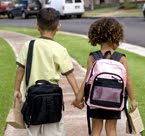Back To School Tips For those of you who have young children returning to school and those whose kids are going to school for the first time, make sure the school year starts off right with these back to school tips from the American Academy of Pediatrics Web site (http://www.aap.org). MAKING THE FIRST DAY EASIER -- Remind your child that he/she is not the only student who is a bit uneasy about the first day of school. Teachers know that students are anxious and will make an extra effort to make sure everyone feels as comfortable as possible. BACKPACK SAFETY -- Choose a backpack with wide, padded shoulder straps and a padded back. TRAVELING TO AND FROM SCHOOL Review the basic rules with your youngster: School Bus Car Walking to School EATING DURING THE SCHOOL DAY -- Most schools regularly send schedules of cafeteria menus home. With this advance information, you can plan on packing lunch on the days when the main course is one your child prefers not to eat. BULLYING Bullying is when one child picks on another child repeatedly. Bullying can be physical, verbal, or social. It can happen at school, on the playground, on the school bus, in the neighborhood, or over the Internet. When Your Child Is Bullied When Your Child Is the Bully When Your Child Is a Bystander BEFORE AND AFTER SCHOOL CHILD CARE -- During middle childhood, youngsters need supervision. A responsible adult should be available to get them ready and off to school in the morning and watch over them after school until you return home from work. DEVELOPING GOOD HOMEWORK AND STUDY HABITS -- Create an environment that is conducive to doing homework. Youngsters need a permanent work space in their bedroom or another part of the home that offers privacy.
-- Point out the positive aspects of starting school: It will be fun. He or she will see old friends and meet new ones. Refresh his/her positive memories about previous years, when he/she may have returned home after the first day with high spirits because he/she had a good time.
-- Find another child in the neighborhood with whom your youngster can walk to school or ride with on the bus.
-- If you feel it is appropriate, drive your child (or walk with him/her) to school and pick him/her up on the first day.
-- Pack light. Organize the backpack to use all of its compartments. Pack heavier items closest to the center of the back. The backpack should never weigh more than 10 to 20 percent of your child's body weight.
-- Always use both shoulder straps. Slinging a backpack over one shoulder can strain muscles.
-- Consider a rolling backpack. This type of backpack may be a good choice for students who must tote a heavy load. Remember that rolling backpacks still must be carried up stairs, and they may be difficult to roll in snow.
-- If your child’s school bus has lap/shoulder seat belts, make sure your child uses one at all times when in the bus. If your child’s school bus does not have lap/shoulder belts, encourage the school to buy or lease buses with lap/shoulder belts.
-- Wait for the bus to stop before approaching it from the curb.
-- Do not move around on the bus.
-- Check to see that no other traffic is coming before crossing.
-- Make sure to always remain in clear view of the bus driver.
-- Children should always board and exit the bus at locations that provide safe access to the bus or to the school building.
-- All passengers should wear a seat belt and/or an age- and size-appropriate car safety seat or booster seat.
-- Your child should ride in a car safety seat with a harness as long as possible and then ride in a belt-positioning booster seat. Your child is ready for a booster seat when she has reached the top weight or height allowed for her seat, her shoulders are above the top harness slots, or her ears have reached the top of the seat.
-- Your child should ride in a belt-positioning booster seat until the vehicle's seat belt fits properly (usually when the child reaches about 4' 9" in height and is between 8 to 12 years of age). This means that the child is tall enough to sit against the vehicle seat back with her legs bent at the knees and feet hanging down and the shoulder belt lies across the middle of the chest and shoulder, not the neck or throat; the lap belt is low and snug across the thighs, and not the stomach.
-- All children under 13 years of age should ride in the rear seat of vehicles. If you must drive more children than can fit in the rear seat (when carpooling, for example), move the front-seat passenger’s seat as far back as possible and have the child ride in a booster seat if the seat belts do not fit properly without it.
-- Remember that many crashes occur while novice teen drivers are going to and from school. You should require seat belt use, limit the number of teen passengers, do not allow eating, drinking, cell phone conversations or texing to prevent driver distraction; and limit nighttime driving and driving in inclement weather. Familiarize yourself with your teen's graduated drive license law and consider the use of a parent-teen driver agreement to facilitate the early driving learning process.
-- Make sure your child's walk to school is a safe route with well-trained adult crossing guards at every intersection.
-- Be realistic about your child's pedestrian skills. Because small children are impulsive and less cautious around traffic, carefully consider whether or not your child is ready to walk to school without adult supervision.
-- If your child is young or is walking to a new school, walk with them the first week to make sure they know the route and can do it safely.
-- Bright colored clothing will make your child more visible to drivers.
-- In neighborhoods with higher levels of traffic, consider starting a "walking school bus", in which an adult accompanies a group of neighborhood children walking to school.
-- Try to get your child's school to stock healthy choices such as fresh fruit, low-fat dairy products, water and 100 percent fruit juice in the vending machines.
-- Each 12-ounce soft drink contains approximately 10 teaspoons of sugar and 150 calories. Drinking just one can of soda a day increases a child's risk of obesity by 60%. Restrict your child's soft drink consumption.
-- Help your child learn how to respond by teaching your child how to:
1. Look the bully in the eye.
2. Stand tall and stay calm in a difficult situation.
3. Walk away.
-- Teach your child how to say in a firm voice.
1. "I don't like what you are doing."
2. "Please do NOT talk to me like that."
3. "Why would you say that?"
-- Teach your child when and how to ask for help.
-- Encourage your child to make friends with other children.
-- Support activities that interest your child.
-- Alert school officials to the problems and work with them on solutions.
-- Make sure an adult who knows about the bullying can watch out for your child's safety and well-being when you cannot be there.
-- Be sure your child knows that bullying is never OK.
-- Set firm and consistent limits on your child's aggressive behavior.
-- Be a positive role mode. Show children they can get what they want without teasing, threatening or hurting someone.
-- Use effective, non-physical discipline, such as loss of privileges.
-- Develop practical solutions with the school principal, teachers, counselors, and parents of the children your child has bullied.
-- Tell your child not to cheer on or even quietly watch bullying.
-- Encourage your child to tell a trusted adult about the bullying.
-- Help your child support other children who may be bullied. Encourage your child to include these children in activities.
-- Encourage your child to join with others in telling bullies to stop.
-- Children approaching adolescence (11- and 12-year-olds) should not come home to an empty house in the afternoon unless they show unusual maturity for their age.
-- If alternate adult supervision is not available, parents should make special efforts to supervise their children from a distance. Children should have a set time when they are expected to arrive at home and should check in with a neighbor or with a parent by telephone.
-- If you choose a commercial after-school program, inquire about the training of the staff. There should be a high staff-to-child ratio, and the rooms and the playground should be safe.
-- Set aside ample time for homework.
-- Establish a household rule that the TV set stays off during homework time.
-- Supervise computer and Internet use.
-- Be available to answer questions and offer assistance, but never do a child's homework for her.
-- Take steps to help alleviate eye fatigue, neck fatigue and brain fatigue while studying. It may be helpful to close the books for a few minutes, stretch, and take a break periodically when it will not be too disruptive.
-- If your child is struggling with a particular subject, and you aren't able to help her yourself, a tutor can be a good solution. Talk it over with your child's teacher first.
Shop Amazon
Subscribe to:
Post Comments (Atom)


















No comments:
Post a Comment
Got something - Leave us a comment